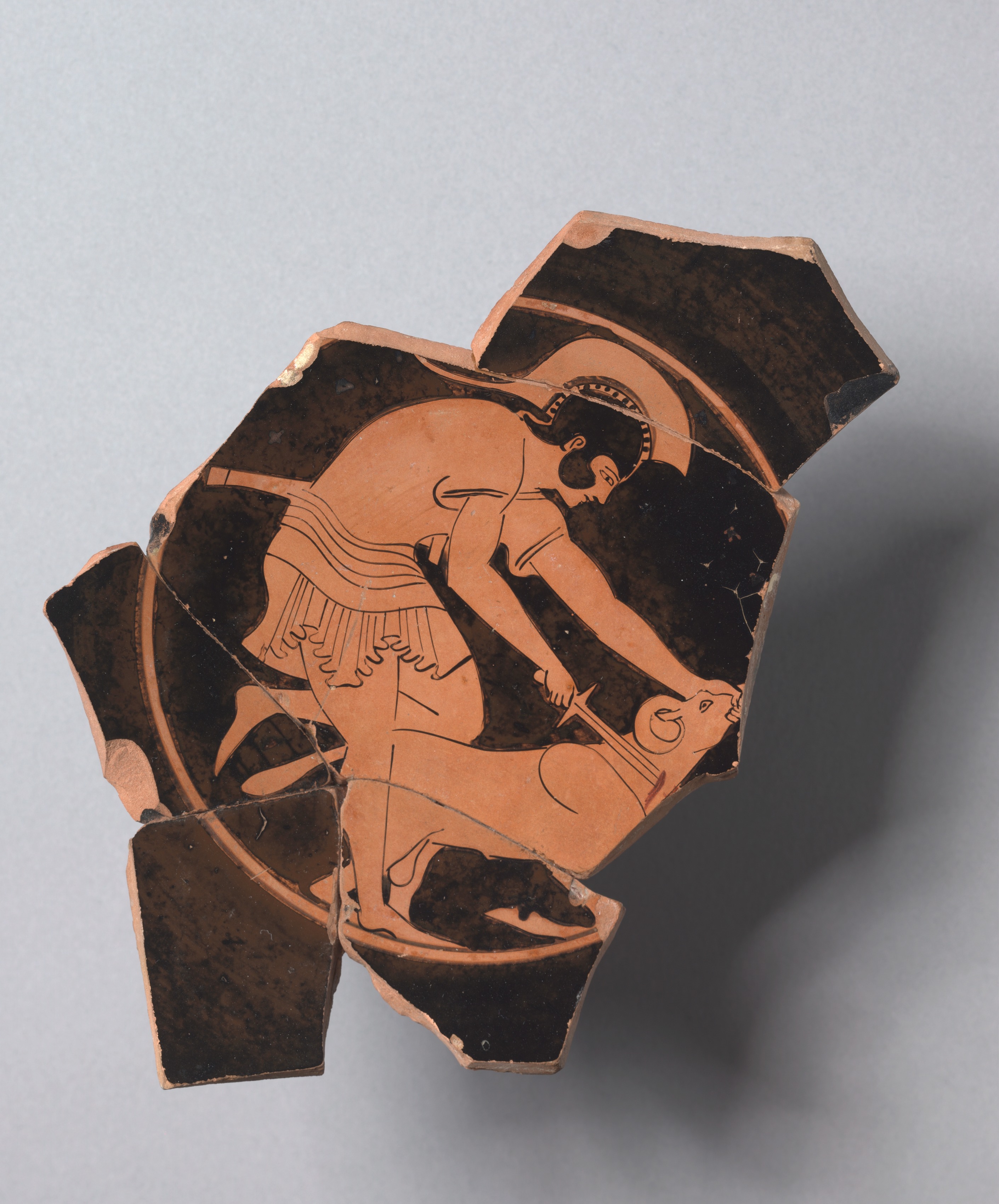The Cleveland Museum of Art
Collection Online as of April 24, 2024

Fragmentary Red-Figure Kylix (Drinking Cup): Warrior Sacrificing Ram
c. 490–480 BCE
Location: 102B Greek
Did You Know?
The artist has used added red pigment for the blood of the ram.Description
Scenes of sacrifice are rare in Greek art before the late 4th century BC. The warrior may be sacrificing the ram as a magical act before battle to save his own and his company's lives. A faded inscription, partly lost, does not identify the warrior; rather, it praises Chairias, probably an Athenian youth. Enough remains of the exterior of the cup to show that it was undecorated.- ?-1926Ludwig Pollak, Rome, Italy, sold to the Cleveland Museum of Art1926-The Cleveland Museum of Art, Cleveland, OH
- Beazley Archive. n.d. Beazley Archive Pottery Database. Oxford: Beazley Archive. BAPD 9003650 www.beazley.ox.ac.ukBeazley, J. D. Attic Red-Figure Vase-Painters. Oxford: Clarendon Press, 1963. P. 1570.12 (Chairias kalos); p. 1637.43bis (compare with work of Eucharides Painter).Boulter, C. G., Jenifer Neils, and Gisela Walberg. Corpus Vasorum Antiquorum. Princeton, N.J.: Princeton University Press, 1971. p. 23, Plate 37, I www.beazley.ox.ac.ukAllentown Art Museum, Gloria Ferrari, and Brunilde Sismondo Ridgway. Aspects of Ancient Greece: An Exhibition Organized by the Allentown Art Museum with the Cooperation of Gloria Ferrari Pinney and Brunilde Sismondo Ridgway ... Allentown Art Museum, September 16 Through December 30, 1979. [Allentown, Pa.]: The Museum, 1979. Pp. 76-77 (cat. 35).Van Straten, F. T. Hierà Kalá: Images of Animal Sacrifice in Archaic and Classical Greece. Leiden: E.J. Brill, 1995. Pp. 16, 219 ( V144), fig. 112.Immerwahr, Henry R. A Corpus of Attic Vase Inscriptions (CAVI). [Place of publication not identified]: [publisher not identified], 1998. p. 790, no. 3200Ekroth, Gunnel. "The Sacrificial rituals of Greek hero-cults in the Archaic to the early Hellenistic Periods." Kernos Supplément 12 (2002). p. 272, fig. 11Gebauer, Jörg. Pompe und Thysia: Attische Tieropferdarstellungen auf schwarz- und rotfigurigen Vasen. Münster: Ugarit-Verlag, 2002. p. 729, Fig.138Ta Attika: Attic Figured Vases from Gela. Roma: L'Erma di Bretschneider, 2004. 322.G77Lexicon Iconographicum Mythologiae Classicae (Organization). Thesaurus cultus et rituum antiquorum. Basel: Fondation pour le lexicon iconographicum mythologiae classicae, 2004. PL.22.GR359Flower, Michael A. The Seer in Ancient Greece. Berkeley: University of California Press, 2008. p. 163, fig 14Hornblower, Simon. A commentary on Thucydides. Vol. 3, Vol. 3. Oxford: Oxford University Press, 2008. p. 477, fig. 4Xenophon, Robert B. Strassler, and John Marincola. The Landmark Xenophon's Hellenika: a new translation. London: Quercus, 2011. p. 134, Fig.4.2.23BEkroth, Gunnel. "Castration, Cult and Agriculture: Perspectives on Greek Animal Sacrifice." Opuscula Annual of the Swedish Institutes at Athens and Rome 7 (2014).
p. 160, Fig. 5 ecsi.bokorder.seJameson, Michael H. Cults and Rites in Ancient Greece: Essays on Religion and Society. 2015. p. 115, Fig.6.1Oakley, John Howard. A Guide to Scenes of Daily Life on Athenian Vases. 2020. Mentioned and reproduced: p. 173, fig. 8.7 - Ancient Art of Greece and Rome. Allentown Art Museum, Allentown, PA (organizer) (September 16-December 29, 1979).
- {{cite web|title=Fragmentary Red-Figure Kylix (Drinking Cup): Warrior Sacrificing Ram|url=false|author=|year=c. 490–480 BCE|access-date=24 April 2024|publisher=Cleveland Museum of Art}}
Source URL:
https://www.clevelandart.org/art/1926.242